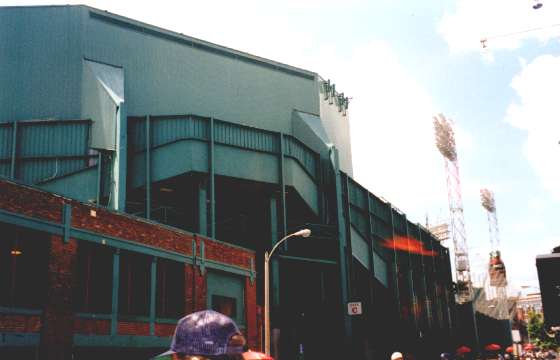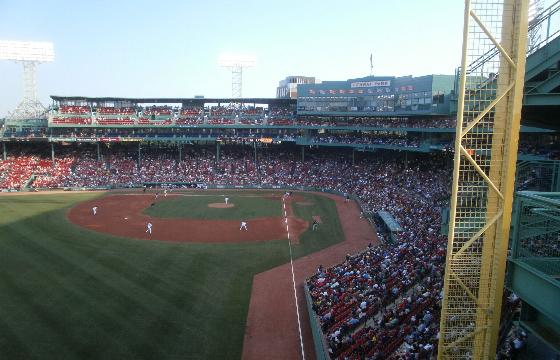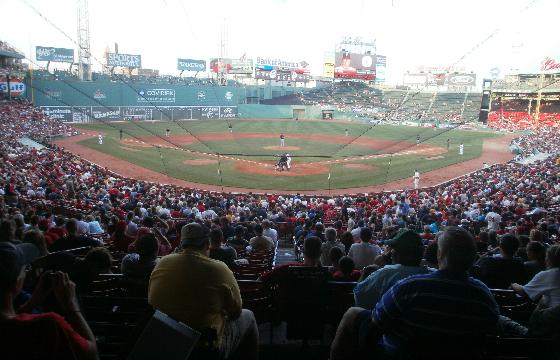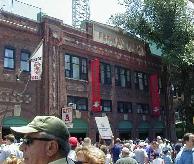 An unusual external view of Fenway: from behind the bleachers, Jul-1998. |
 A look at the main seating bowl from atop the “Green Monster” in left field, Aug-2011. |
 The expanse of the field from directly behind the plate, Aug-2011. |
 An unusual external view of Fenway: from behind the bleachers, Jul-1998. |
 A look at the main seating bowl from atop the “Green Monster” in left field, Aug-2011. |
 The expanse of the field from directly behind the plate, Aug-2011. |
 Chronological Tour: Stop 4 Chronological Tour: Stop 4 |




 5 baseballs
5 baseballs
It’s located in a part of Boston that makes it inconvenient for all but mass transit (and thank goodness for mass transit). The streets are narrow, and parking is relatively scarce and expensive. And the park itself still contains a lot of dark corridors, narrow tread between seating rows, and old wooden seats. The Red Sox promote the park as “Friendly Fenway”, because the only way to cope in these cramped quarters is to be friendly.
 The front of the park, on Jersey Street. |
There is always that left-field wall, a manual scoreboard tucked into its base, which turned green when the advertising signs were painted over in 1947 (there are now monochrome advertisments painted on it). There’s the quirky shape of the wall in center, where not only does the fence line take on a strange dimension, but so does the home-run line. There’s the low porch in right-center. There’s “Pesky’s pole” in right field, where an extremely short right-field line shoots out to a deep alley in no time flat. A ball landing fair along that fence can roll forever, as Nomar Garciaparra proved when he dropped one there and beat out an inside-the-park home run when I was in attendance 26-Jul-1998.
There are ghosts here, too. The joy of Carlton Fisk’s ball down the line that just stayed fair in 1975, tempered by the one Bucky Dent hit into the screen in 1978. The home run Ted Williams hit on the final swing of his career in 1960. And the heartbreak that lingered for eight decades, since Harry Frazee sold his 29-homer man, Babe Ruth, to the Yankees after the 1919 season, finally cured when the Sox announced they were staying at Fenway for a while rather than succumbing to the pressure to build a new park. They went on to win the championship of Major League Baseball again four times in fifteen seasons between 2004 and 2018.
It’s all there, on a visit to this historic park. Tickets are the most expensive around, thanks to its small capacity, but they’re worth every penny.
For a while, they were talking about building a park with identical dimensions, including the Green Monster, but with larger seating capacity and more accommodating to fans and players alike, right across the street. They said it would look like Fenway, and it would play like Fenway – but it wouldn’t be Fenway. Fortunately, with the recent expansions, the park is expected to remain intact for the foreseeable future.
The Red Sox held a 100th-anniversary celebration lasting throughout the 2012 season, and the party was well-deserved. If you’re a baseball fan, and you haven’t made it to the Hub to see this marvel, I urge you: Do whatever you can to get there. You won’t be disappointed.
From the 1970s, Jersey Street, which runs along the third-base grandstand, was named Yawkey Way in honor of team owner Tom Yawkey, who bought the club in 1933 and led the successful renovation of Fenway Park in 1934. However, sentiment developed early in the 21st century to remove Yawkey’s name from the street, as he refused to integrate the team roster until 1959, when he finally brought up “Pumpsie” Green. In May 2018, the street name reverted to Jersey Street.
| Game | Date | League | Level | Result |
|---|---|---|---|---|
| 27 | Mon 27-Jun-1988 | American | MLB | BOSTON 9, Cleveland 5 |
| 133 | Sat 23-Jul-1994 | American | MLB | BOSTON 6, Seattle 5, 1st |
| 134 | Sat 23-Jul-1994 | American | MLB | Seattle 6, BOSTON 3, 11 inn, 2d |
| 209 | Sat 3-Aug-1996 | American | MLB | BOSTON 6, Minnesota 3 |
| 259 | Sun 27-Jul-1997 | American | MLB | BOSTON 6, Anaheim 5 |
| 316 | Sun 26-Jul-1998 | American | MLB | BOSTON 6, Toronto 3 |
| 397 | Sun 19-Sep-1999 | American | MLB | BOSTON 7, Detroit 3 |
| 410 | Sun 9-Jul-2000 | Major | MLB | BOSTON 7, Atlanta 2 |
| 521 | Sat 29-Jun-2002 | Major | MLB | Atlanta 2, BOSTON 1 |
| 590 | Sun 29-Jun-2003 | Major | MLB | BOSTON 11, Florida 7 |
| 1149 | Sat 20-Aug-2011 | Eastern | AA | Binghamton 6, PORTLAND 4, 11 inn |
| 1150 | Sat 20-Aug-2011 | International | AAA | Syracuse 3, PAWTUCKET 1 |
| 1304 | Fri 18-Apr-2014 | Major | MLB | Baltimore 8, BOSTON 4 |
| 1635 | Fri 25-May-2018 | Major | MLB | BOSTON 6, Atlanta 2 |